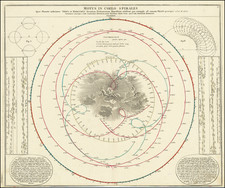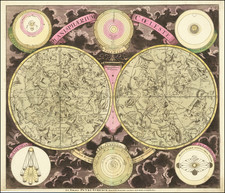An Important Map of the Moon With Hidden Dedications to the Maker and Artist's Wives!
A fine reduction of Jean-Dominique Cassini's important work, one of the earliest available scientific maps of the moon.
This map was originally published in 1679 by Jean-Dominique Cassini from drawings by Claude Mellan (1598-1688). This second printing of the map was published by Cassini's great-grandson, of the same name but more commonly known as Cassini IV (1748-1845), who in 1784 was the director of the Paris Observatory.
In 1787, Cassini IV found the original copperplate of his great-grandfather's lunar map in the Observatory's archive and reissued it. This second edition is identical to the first, aside from the addition of Carte de la Lune ... de Jean Dominique Cassini to the lower edge. Cassini IV also published his own reduced version the following year, the present work (Launay).
The famous Cassini map shows details on the lunar surface observed through a telescope of twenty feet in length or more. Cassini I was a student of the astronomer Giovanni Baptist Riccioli (1598-1671), who was responsible for naming Mare Tranquilitatus.
Cassini's map is accompanied by a description of the formations named after noted polymaths such as Galileo, Kepler and Copernicus, and as well as a description of 'newer' discoveries.
There are two rather dedications interwoven into the moon’s surface, supposedly to Cassini’s wife, Geneviève de Laistre and to the wife of artist Jean Patigny (d. 1675). One is a profile of a woman’s head which features in the lower half by the mountain range “Heraclides”. The other appears in the Mare Serenitis, a heart shape or the Greek letter phi (φ) as in philos - meaning love.
Cassini IV added labels to significant lunar features on this reduction, as well as a substantial historical note detailing the discoveries made by his great-grandfather and other astronomers. The labels follow the nomenclature of Cassini I's teacher, Giovanni Battista Riccioli, first laid out in his 'Almagestum Movun' in 1651. It divided the visible surface of the Moon into octants, with the features in each named for a certain period of history. Octant VIII contains the names of Riccioli's contemporaries. The names of Copernicus, Galileo and Kepler appear in the Sea of Storms. Riccioli credited several Arab astronomers by naming craters after them, despite a tendency in Christian scholars to gloss over their achievements, for example, Azophi and Arzachel (Abd al-Rahman al-Sufi and Al-Zarkali) in the upper portion of the map.
Rarity
The map is very rare on the market.
OCLC locates 3 examples: BNF, ETH-Bibliothek Zurich, and Utrecht University Library.









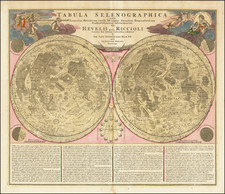
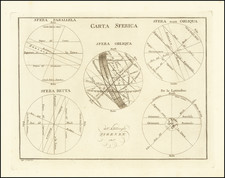
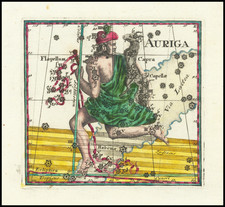
![[Synopsis Coeli Superioris] and [Synopsis Coeli Inferioris Austrina]](https://storage.googleapis.com/raremaps/img/small/83287.jpg)
